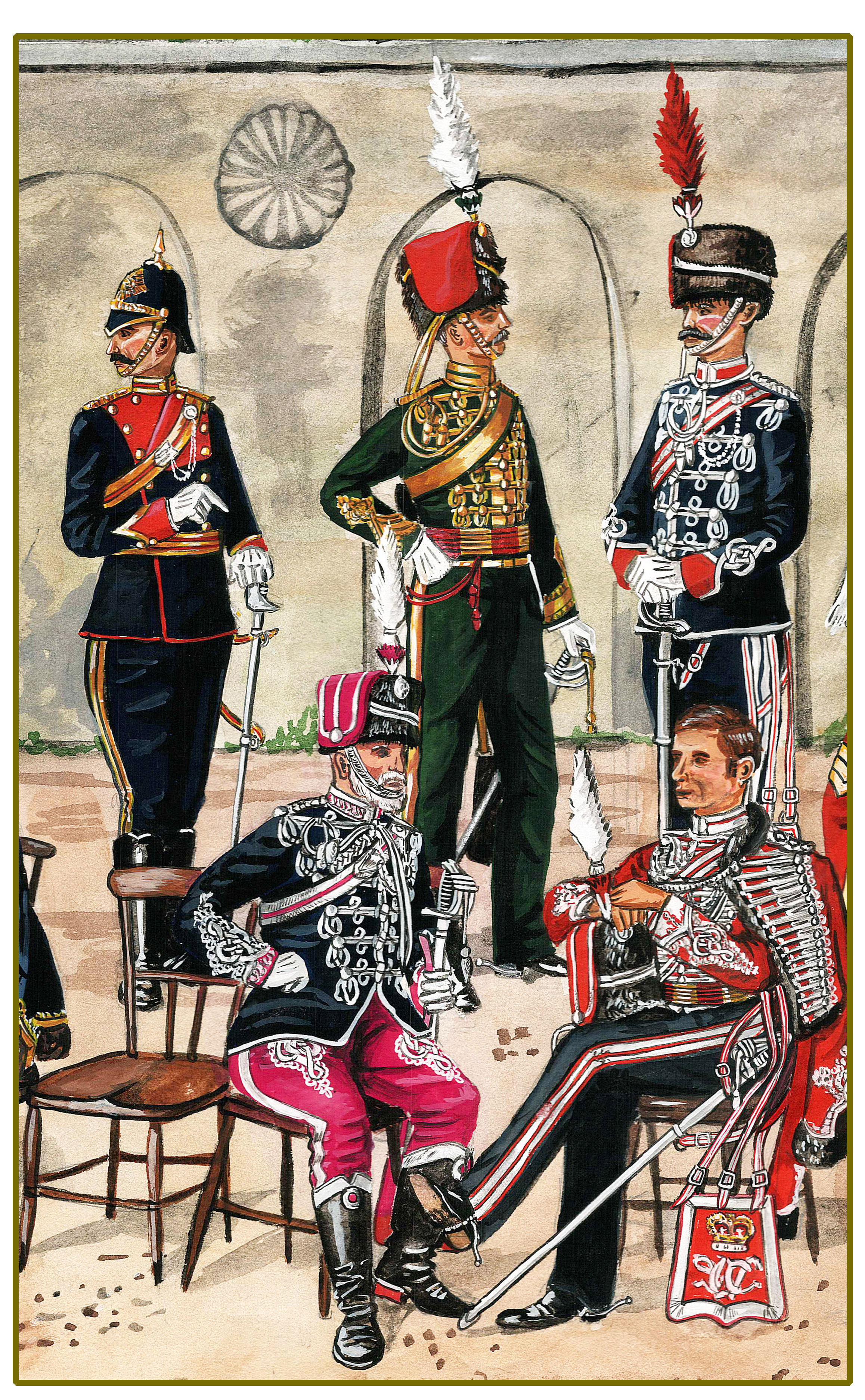UNIFORMS OF THE
BRITISH YEOMANRY REGIMENTS
1895-1900
THE YEOMANRY CAVALRY OF GREAT BRITAIN
From its formation as volunteer or fencible cavalry in 1794, the yeomanry became an important part of the fabric of the British Army, especially for home defence. The threat of invasion has more than often spurred the raising of volunteer units, both cavalry and infantry particularly as the regular army has generally been engaged overseas. The Royal Navy, of course was always the primary and most effective line of defence against invasion. The militia, consisting mostly of infantry units, was an ancient organization which by the time of the French Revolution was a semi-conscripted reserve force of dubious reliability. The Yeomanry provided a light mobile force which could react in case an enemy landing took place. This was just the case when the French did make a landing at Fishguard, Wales in 1797. Part of the responding force was the Castlemartin Yeomanry who provided the first and only battle honour for the Yeomanry until the 20th century.
After the Napoleonic Wars, much of the yeomanry was disbanded and the various regiments (sometimes reduced to one or two troops) that remained were often called out to quell civilian unrest. The infamous “Peterloo Massacre” being the most well-known event. In the eighteen-fifties, invasion threats again led to the formation of new volunteer units such as the Rifle Volunteer movement along with light horse and mounted rifle units as well as artillery and engineer corps. This movement also prompted the re-raising of some Yeomanry regiments and the expansion of existing ones.
By the mid nineteenth century, the Yeomanry had become a fashionable element in many counties of England, Scotland and Wales. Prominent landowners, squires and nobility became colonels and officers of the regiments. There was little civil unrest in these times and training exercises, field days and reviews along with the annual camp became the normal routine with many such events becoming major social occasions. Since the War office only provided the yeomanry with arms and some military equipment the regiments had to provide their own mounts and uniforms. Commanders therefore clothed their units as they saw fit. Regimental designations began to use the terms “Hussars and “Dragoons” in their titles. The Cardwell reforms did not leave the volunteer forces untouched. The linking of Rifle Volunteer corps to infantry regiments saw them eventually become additional battalions in regular regiments by 1881. The War Office began to see the role of auxiliary cavalry as Mounted Reconnaissance and in the 1880’s they became liable for service anywhere in the country and by the end of the century they were brigaded into pairs of regiments. In 1899 the Boer war began and as disaster followed disaster in South Africa, the demand for more troops led to the creation of the Imperial Yeomanry in 1900. This force was to supplement the cavalry with a mobile force to match the manouvrebility of the Boers. More than 34,000 answered the call and by wars end 39 battalions had served earning a firm place in British military history.
The Imperial Yeomanry endured until 1908 when the Haldane reforms organized the volunteer force into a true reserve element. As such, the yeomanry went to war in 1914 as an efficient cavalry component of the British army and earned more laurels in the next four years, especially in the Middle-East.
UNIFORMS
The first uniforms of the Yeomanry cavalry when formed in 1794 reflected the styles of the regular light cavalry. Short jackets of blue, scarlet or green with, by 1800 cloth loops across the front were commonly worn. Helmets were mostly of the ‘Tarleton’ style with central brush comb from front to rear. White breeches and boots were worn with some adopting overalls by the end of the Napoleonic Wars. After the many disbandments following that war, the Yeomanry adopted more traditional light dragoon uniforms, again with scarlet or blue coats. By mid-19th century, with the rise of volunteer and yeomanry units the uniforms became somewhat more unique. Very few appeared dressed as the regular cavalry with mixtures of hussar uniforms with dragoon headdress and vice-versa. Hussar units, whose funding received very little government input retained styles reminiscent of the pre-Crimean uniforms and those who did adopt tunics sometimes had only three or four loops (or even none at all!).
Although regulations dictated that Yeomanry and volunteers were restricted to silver lace, not all units complied. By 1890s the yeomanry was strongly encouraged to adopt hussar uniforms and many regiments did so, often with small details unique to themselves. Sixteen of the 38 regiments wore conventional hussar uniforms and eleven were dressed as dragoons. By 1900 the entire Yeomanry force would appear in full dress for the last time as the formation of the Imperial Yeomanry for the Boer War would see them dressed in some form of khaki for the next eight years. In 1908 some regiments reconstituted their pre-1900 full dress while most wore blue, dark green or scarlet frocks sometimes with coloured cuffs along with peaked caps. The new regiments formed during or after the South African War followed the Yeomanry tradition of unique uniforms with many, for the first time, in lancer dress including four with the lancer cap. Officers only wore these brilliant uniforms with other ranks wearing the frock with peaked cap.
The Great War saw the demise of these fine uniforms and they would only be seen in later years by officers at levées and other ranks at special parades and in some cases tattoos.
This brief study is restricted to the period 1895-1900 for the uniforms of other ranks. It will be part of a larger study to be published in book form later.


